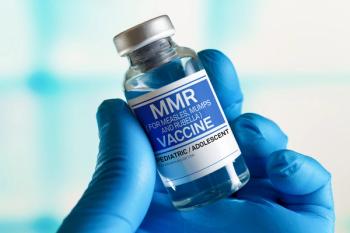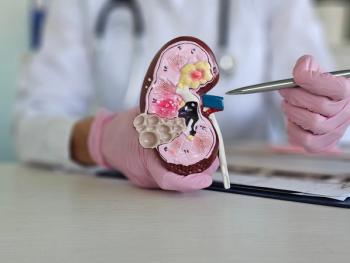
Clinical Overview: A Novel Way of Treating Schizophrenia
The estimated cost burden of schizophrenia is more than $150 billion, consisting of direct treatment cost and lost productivity.
Background
Schizophrenia is a complex psychiatric disorder that is characterized by a syndrome of positive, negative, and cognitive symptoms.1 Onset of symptoms typically occurs in late adolescence or early adulthood, with prevalence equal among genders.
Once a person is diagnosed with this condition, even with improved symptoms, they may still end up with life-challenging consequences, such as social isolation, discrimination, and difficulty establishing relationships.3
Health outcomes for patients with schizophrenia are lower as well. This population is associated with poor diet, smoking, weight gain, substance abuse, and a reduced life expectancy.
The estimated cost burden of schizophrenia is more than $150 billion, consisting of direct treatment cost and lost productivity.6 The DSM-V criteria are used for the diagnosis of schizophrenia.
Pathophysiology and Etiology
The gray matter in the frontal lobe, cingulate gyri, and medial temporal regions of the brain are reduced in size and activity.1 Temporal lobe helps with recognizing people, understanding, and interpreting other people’s emotions.9
Cingulate gyri regulates and processes emotions.10 Frontal lobe plays an important role in memory, intelligence, and personality.9
Neurochemical studies demonstrated a presynaptic increase in dopamine synthesis level at dopaminergic neurons.1,3 The exact etiology is unknown, but there are few possible rationales such as abnormalities of cell development.1
There could be a genetic component, as roughly 1%-2% of patients have changes in the number of copies of small sections of an individual’s genome, which could increase the risk for schizophrenia development. Approximately 6.6% of patients have a first-degree relative with schizophrenia and there is a 40% risk of the disorder if both parents suffer from the disease.2
Clinical Presentation
The first psychotic episode can be abrupt, but it is more commonly preceded by schizoid behavior or socially withdrawn and suspicious behavior.1 During an acute episode, the patient’s brain creates a false reality and can present with any of the positive, negative, or cognitive symptoms.
Positive symptoms indicate an increase in the presence of abnormal behaviors while negative symptoms refer to the absence of normal behaviors.4 Cognitive symptoms involve problems with long-term memory, attention, and executive functions.3 Catatonia, which can be either the lack of or the presence of hyperactive movements and speech, can also occur.2,3
Current Treatment and Issues
The American Psychiatric Association 2020 guideline for schizophrenia treatment recommends an individualized therapy plan that includes nonpharmacological and pharmacological treatments.6 Nonpharmacological approaches include, but are not limited to, cognitive behavioral therapy, psychoeducation, receiving supported employment services, and cognitive remediation.1,6
Pharmacological approaches include starting an antipsychotic agent and monitoring for efficacy and tolerability.6 Second-generation antipsychotics are preferred over first generation because of a more tolerable adverse effect (AE) profile.
The choice of an antipsychotic depends on the patient's preferences, patient response to previous antipsychotics, AE profiles, available formulations, and drug-drug interactions. Once the initial dose of an antipsychotic agent is tolerated, then it can be optimized to a therapeutic level.
If symptoms improve within a couple of weeks at the minimal clinical dose, then it is recommended to continue that agent. If there is no major improvement after several weeks of a new agent, only a partial response, or improvement plateaus, either increase the dose of the current medication or switch to another antipsychotic.
Monitoring the AE profiles of antipsychotics throughout treatment is essential. First-generation antipsychotics work mainly by blocking dopaminergic receptor D2 in the brain.12 Also, they antagonize noradrenergic, cholinergic, and histaminergic receptors. These medications commonly cause movement disorders called extrapyramidal symptoms (EPS), such as akathisia, parkinsonism, dystonia, and tardive dyskinesia.6,12
In contrast, second-generation antipsychoticshave lesser D2 blockage but has serotonin receptor 5-HT2A antagonist action and commonly cause metabolic disorders, such as weight gain, hyperlipidemia, and glucose abnormalities.
A New Path to Treat Schizophrenia
Lumateperone is a second-generation antipsychotic approved by the FDA in 2019.7 It has a unique mechanism of action compared to other antipsychotics in that it antagonizes the central 5HT2A receptors and postsynaptic D2 receptors. The affinity for serotonin receptors is high compared to a moderate affinity for dopamine receptors and a low affinity for muscarinic and histaminergic receptors.
Lumateperone is dosed as a 42 mg capsule daily with or without food. There are no renal adjustments necessary, but the dose should be reduced for moderate to severe hepatic dysfunction. Monitoring parameters are similar to other antipsychotics and include electrolytes, renal and liver function, thyroid function, complete blood counts, EPS, fall risk, glucose, lipids, cognitive function, weight, prolactin, and vital signs.
Lumateperone is generally well tolerated with similar efficacy to other antipsychotics.8 Kane and colleagues reviewed 3 double-blinded, placebo-controlled, randomized trials assessing the use of lumateperone.
The study population consisted of patients aged 18-60 years experiencing acute schizophrenia exacerbation for less than 4 weeks. Efficacy was similar between lumateperone and risperidone and better than placebo.
Discontinuation due to inadequate efficacy was 3.9% in the lumateperone group, 4.3% in the risperidone group, and 8% in the placebo group. Patients were evaluated for safety measures at baseline, weekly during the study, and the end of the trials.
The safety measure was treatment-emergent AEs (TEAEs). Reported TEAEs in both active treatment groups were similar, with the most common being somnolence/sedation and dry mouth.
EPS-related AEs were reported in only 3% of the patients with lumateperone compared to the risperidone group (6.3%). The most common EPS-related AE was akathisia.
Weight gain was more commonly reported in the risperidone group than the lumateperone or placebo groups. Lumateperone was largely correlated with a statistically significant decrease from baseline than risperidone in metabolic parameters, such as total cholesterol, triglyceride, and fasting blood glucose as well as prolactin levels (p <0.001).
There were no significant changes in vital signs between the groups except for a slight increase in heart rate with risperidone. There was only 1 patient in each of the lumateperone (0.2%) and risperidone (0.4%) groups with an increase of greater than 60ms in QTcF, which was not clinically significant. There were slight increases with bilirubin, alanine aminotransferase, and gamma-glutamyl transferase with lumateperone, which were not clinically relevant.
In conclusion, first generation antipsychotics have many AEs, with the most common being EPS-related AEs such as akathisia and tardive dyskinesia. On the other hand, second-generation antipsychotics have less movement disorder issues compared to the first-generation but have more metabolic disorders.
In the pooled analysis, lumateperone has been shown to have a similar efficacy and AE profile as a commonly used first-line, second-generation antipsychotic. Lumateperone may be used as a first-line treatment for schizophrenia, and with its unique mechanism, may be beneficial to patients who failed other second-generation antipsychotics, though this role will need to be confirmed in future studies.
About the Author
Haseeb Foroghi, PharmD Candidate Class of 2023, Texas Tech University Health Science Center.
References
- Crismon M, Smith TL, Buckley PF. Schizophrenia. In: DiPiro JT, Yee GC, Michael Posey LL, Haines ST, Nolin TD, Ellingrod VL. eds. DiPiro: Pharmacotherapy A Pathophysiologic Approach, 12e. McGraw Hill; 2021. Accessed December 29, 2022.
https://accesspharmacy-mhmedicalcom.ezproxy.ttuhsc.edu/content.aspx?bookid=3097§ionid=267918845 - Reus VI. Schizophrenia. In: Jameson J, Fauci AS, Kasper DL, Hauser SL, Longo DL, Loscalzo J. eds. Harrison's Principles of Internal Medicine, 20e. McGraw Hill; 2018. Accessed December 29, 2022.
https://accesspharmacy-mhmedical-com.ezproxy.ttuhsc.edu/content.aspx?bookid=2129§ionid=251889613 - Jauhar S, Johnstone M, McKenna PJ. Schizophrenia. Lancet. 2022;399(10323):473-486. doi:10.1016/S0140-6736(21)01730-X
- Correll CU, Schooler NR. Negative Symptoms in Schizophrenia: A Review and Clinical Guide for Recognition, Assessment, and Treatment. Neuropsychiatr Dis Treat. 2020;16:519-534. Published 2020 Feb 21. doi:10.2147/NDT.S225643
- Fischer BA, Buchanan RW. Schizophrenia in Adults: Clinical Manifestations, Course, Assessment, and Diagnosis. UptoDate. September 29, 2022. Accessed January 5, 2023.
https://www-uptodate-com.ezproxy.ttuhsc.edu/contents/schizophrenia-in-adults-clinical-manifestations-course-assessment-and-diagnosis?search=schizophrenia%20symptoms&source=search_result&selectedTitle=1~150&usage_type=default&display_rank=1#references - Keepers GA, Fochtmann LJ, Anzia JM, et al. The American Psychiatric Association Practice Guideline for the Treatment of Patients With Schizophrenia. Am J Psychiatry. 2020;177(9):868-872. doi:10.1176/appi.ajp.2020.177901
- Lumateperone. In: Lexi-drugs [database online]. Hudson, Ohio: Wolters Kluwer Health. Updated periodically. Accessed May 19, 2023.
- Kane JM, Durgam S, Satlin A, et al. Safety and tolerability of lumateperone for the treatment of schizophrenia: a pooled analysis of late-phase placebo- and active-controlled clinical trials. Int Clin Psychopharmacol. 2021;36(5):244-250. doi:10.1097/YIC.0000000000000371
- Brain. Cleveland Clinic. Reviewed March 30, 2022. Accessed May 19, 2023.
https://my.clevelandclinic.org/health/body/22638-brain - Jumah FR, Dossani RH. Neuroanatomy, Cingulate Cortex. National Library of Medicine. Updated December 6, 2022. Accessed May 19, 2023.
https://www.ncbi.nlm.nih.gov/books/NBK537077/ - Orellana G, Slachevsky A. Executive functioning in schizophrenia. Front Psychiatry. 2013;4:35. Published 2013 Jun 24. doi:10.3389/fpsyt.2013.00035
- K Chokhawala, L Stevens. Antipsychotic Medications. National Library of Medicine. Updated February 26, 2023. Accessed May 19, 2023.
https://www.ncbi.nlm.nih.gov/books/NBK519503/#:~:text=First%2Dgeneration%20antipsychotics%20are%20dopamine,also%20known%20as%20atypical%20antipsychotics . - Tandon R. Schizophrenia and Other Psychotic Disorders in Diagnostic and Statistical Manual of Mental Disorders (DSM)-5: Clinical Implications of Revisions from DSM-IV. Indian J Psychol Med. 2014;36(3):223-225. doi:10.4103/0253-7176.135365.
Newsletter
Stay informed on drug updates, treatment guidelines, and pharmacy practice trends—subscribe to Pharmacy Times for weekly clinical insights.














































































































































































































